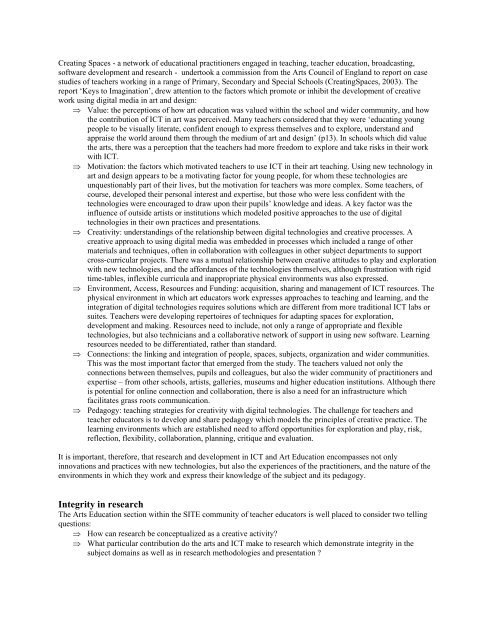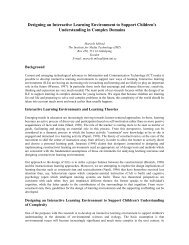ICT and Arts Education - for Art's Sake? - Society for Information ...
ICT and Arts Education - for Art's Sake? - Society for Information ...
ICT and Arts Education - for Art's Sake? - Society for Information ...
Create successful ePaper yourself
Turn your PDF publications into a flip-book with our unique Google optimized e-Paper software.
Creating Spaces - a network of educational practitioners engaged in teaching, teacher education, broadcasting,software development <strong>and</strong> research - undertook a commission from the <strong>Arts</strong> Council of Engl<strong>and</strong> to report on casestudies of teachers working in a range of Primary, Secondary <strong>and</strong> Special Schools (CreatingSpaces, 2003). Thereport ‘Keys to Imagination’, drew attention to the factors which promote or inhibit the development of creativework using digital media in art <strong>and</strong> design:⇒ Value: the perceptions of how art education was valued within the school <strong>and</strong> wider community, <strong>and</strong> howthe contribution of <strong>ICT</strong> in art was perceived. Many teachers considered that they were ‘educating youngpeople to be visually literate, confident enough to express themselves <strong>and</strong> to explore, underst<strong>and</strong> <strong>and</strong>appraise the world around them through the medium of art <strong>and</strong> design’ (p13). In schools which did valuethe arts, there was a perception that the teachers had more freedom to explore <strong>and</strong> take risks in their workwith <strong>ICT</strong>.⇒ Motivation: the factors which motivated teachers to use <strong>ICT</strong> in their art teaching. Using new technology inart <strong>and</strong> design appears to be a motivating factor <strong>for</strong> young people, <strong>for</strong> whom these technologies areunquestionably part of their lives, but the motivation <strong>for</strong> teachers was more complex. Some teachers, ofcourse, developed their personal interest <strong>and</strong> expertise, but those who were less confident with thetechnologies were encouraged to draw upon their pupils’ knowledge <strong>and</strong> ideas. A key factor was theinfluence of outside artists or institutions which modeled positive approaches to the use of digitaltechnologies in their own practices <strong>and</strong> presentations.⇒ Creativity: underst<strong>and</strong>ings of the relationship between digital technologies <strong>and</strong> creative processes. Acreative approach to using digital media was embedded in processes which included a range of othermaterials <strong>and</strong> techniques, often in collaboration with colleagues in other subject departments to supportcross-curricular projects. There was a mutual relationship between creative attitudes to play <strong>and</strong> explorationwith new technologies, <strong>and</strong> the af<strong>for</strong>dances of the technologies themselves, although frustration with rigidtime-tables, inflexible curricula <strong>and</strong> inappropriate physical environments was also expressed.⇒ Environment, Access, Resources <strong>and</strong> Funding: acquisition, sharing <strong>and</strong> management of <strong>ICT</strong> resources. Thephysical environment in which art educators work expresses approaches to teaching <strong>and</strong> learning, <strong>and</strong> theintegration of digital technologies requires solutions which are different from more traditional <strong>ICT</strong> labs orsuites. Teachers were developing repertoires of techniques <strong>for</strong> adapting spaces <strong>for</strong> exploration,development <strong>and</strong> making. Resources need to include, not only a range of appropriate <strong>and</strong> flexibletechnologies, but also technicians <strong>and</strong> a collaborative network of support in using new software. Learningresources needed to be differentiated, rather than st<strong>and</strong>ard.⇒ Connections: the linking <strong>and</strong> integration of people, spaces, subjects, organization <strong>and</strong> wider communities.This was the most important factor that emerged from the study. The teachers valued not only theconnections between themselves, pupils <strong>and</strong> colleagues, but also the wider community of practitioners <strong>and</strong>expertise – from other schools, artists, galleries, museums <strong>and</strong> higher education institutions. Although thereis potential <strong>for</strong> online connection <strong>and</strong> collaboration, there is also a need <strong>for</strong> an infrastructure whichfacilitates grass roots communication.⇒ Pedagogy: teaching strategies <strong>for</strong> creativity with digital technologies. The challenge <strong>for</strong> teachers <strong>and</strong>teacher educators is to develop <strong>and</strong> share pedagogy which models the principles of creative practice. Thelearning environments which are established need to af<strong>for</strong>d opportunities <strong>for</strong> exploration <strong>and</strong> play, risk,reflection, flexibility, collaboration, planning, critique <strong>and</strong> evaluation.It is important, there<strong>for</strong>e, that research <strong>and</strong> development in <strong>ICT</strong> <strong>and</strong> Art <strong>Education</strong> encompasses not onlyinnovations <strong>and</strong> practices with new technologies, but also the experiences of the practitioners, <strong>and</strong> the nature of theenvironments in which they work <strong>and</strong> express their knowledge of the subject <strong>and</strong> its pedagogy.Integrity in researchThe <strong>Arts</strong> <strong>Education</strong> section within the SITE community of teacher educators is well placed to consider two tellingquestions:⇒ How can research be conceptualized as a creative activity?⇒ What particular contribution do the arts <strong>and</strong> <strong>ICT</strong> make to research which demonstrate integrity in thesubject domains as well as in research methodologies <strong>and</strong> presentation ?
















